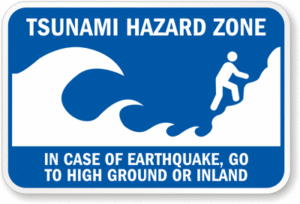In 1812 an epic tsunami inundated the Ventura area. The surge of water deposited a large sailing vessel floating in the harbor all the way inland to Santa Paula and residents of the Mission San Buenaventura spent the next two years living on the hillside in fear of another calamity.
Representatives of several state and local agencies hosted a meeting on Tsunami Preparedness at the Ventura County Fairgrounds on Tuesday, Mar 28th attended by approximately 200 concerned citizens.
An elderly man who would only give his first name – Ray – stated that he was as uncertain as before the meeting regarding what he would do if a tsunami threatened his home in the Ventura Keys neighborhood. “They told us that we would have 15 minutes warning to get to high ground,” Ray noted, “and that we should walk or take our cars if we are elderly and infirm, but if everyone in the neighborhood tries to drive I am afraid there will be gridlock.” Speakers acknowledged past confusion as to the evacuation plans, and cautioned that the meeting was only one component of the first stage of revised plan.
Ventura neighborhoods in the “inundation zone” – the most vulnerable to a tsunami surge – are generally the areas on the seaward side of Highway 101, specifically the Ventura Keys, the Harbor, and the Pierpont neighborhoods. Unlike Japan and other tsunami vulnerable zones on the Pacific Rim, geologic conditions in the Ventura area would likely limit the wave (officially it is a “surge” but the scientist at the event consistently reverted to the term ”wave”) to a height of 15 to 20 feet. Nonetheless the potential for loss of life and immense property damage are present in Ventura, but with an anticipated 15-20 minute warning most Venturans can get to safety if they are alert and prepared.
Speakers urged the audience to make a family plan for a tsunami event much like they would in case of a fire or an earthquake. If an earthquake occurs and you are in a low lying area by the coast immediately seek higher ground. If you are at the beach and hear a louder than normal ocean roar, or if the sea floor is exposed, get to high ground or, if no high ground is near, go to the nearest sturdy structure to get above the surge, which is not just water but also a morass of debris and mud. The threat lasts longer than one wave and can be present for 24 hours after the precipitating event.
Visit www.vcemergency.com for more information and to go to www.vcalert.org or text VCALERT to 313131 to sign up for the free countywide emergency alert system, In the event of emergency locals can also tune into KTVA 1690, and the Emergency Alert System in place since the 1950s will also provide warning should a tsunami threaten Ventura.

